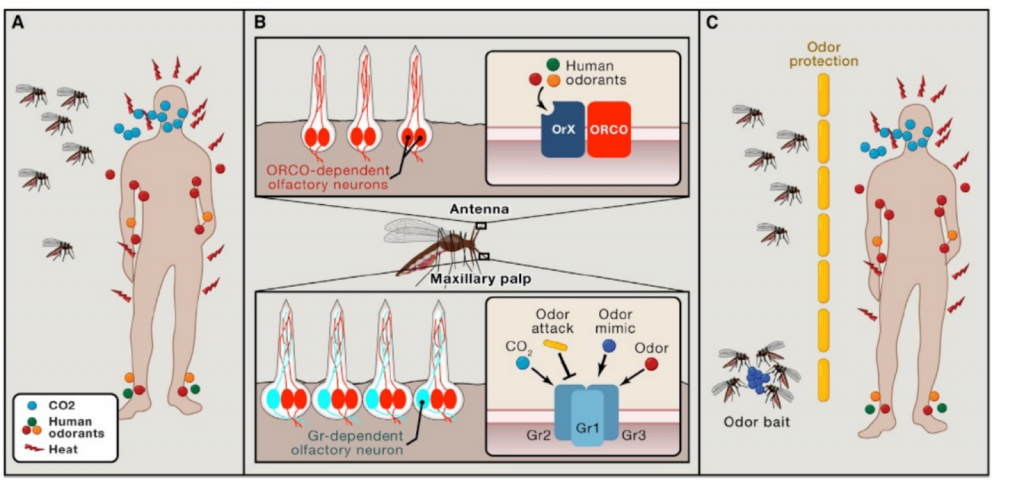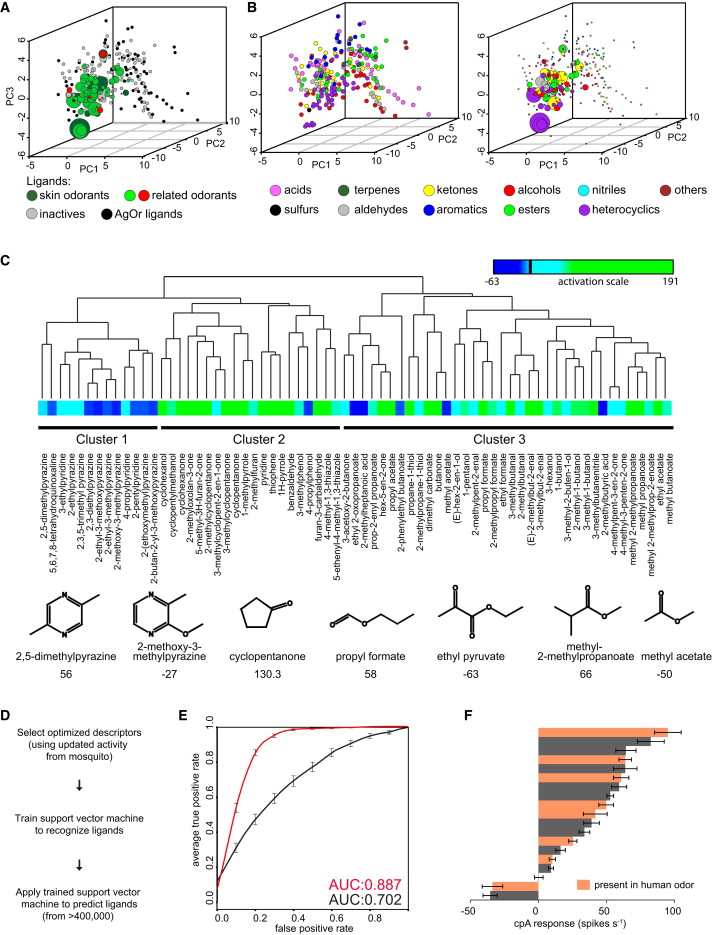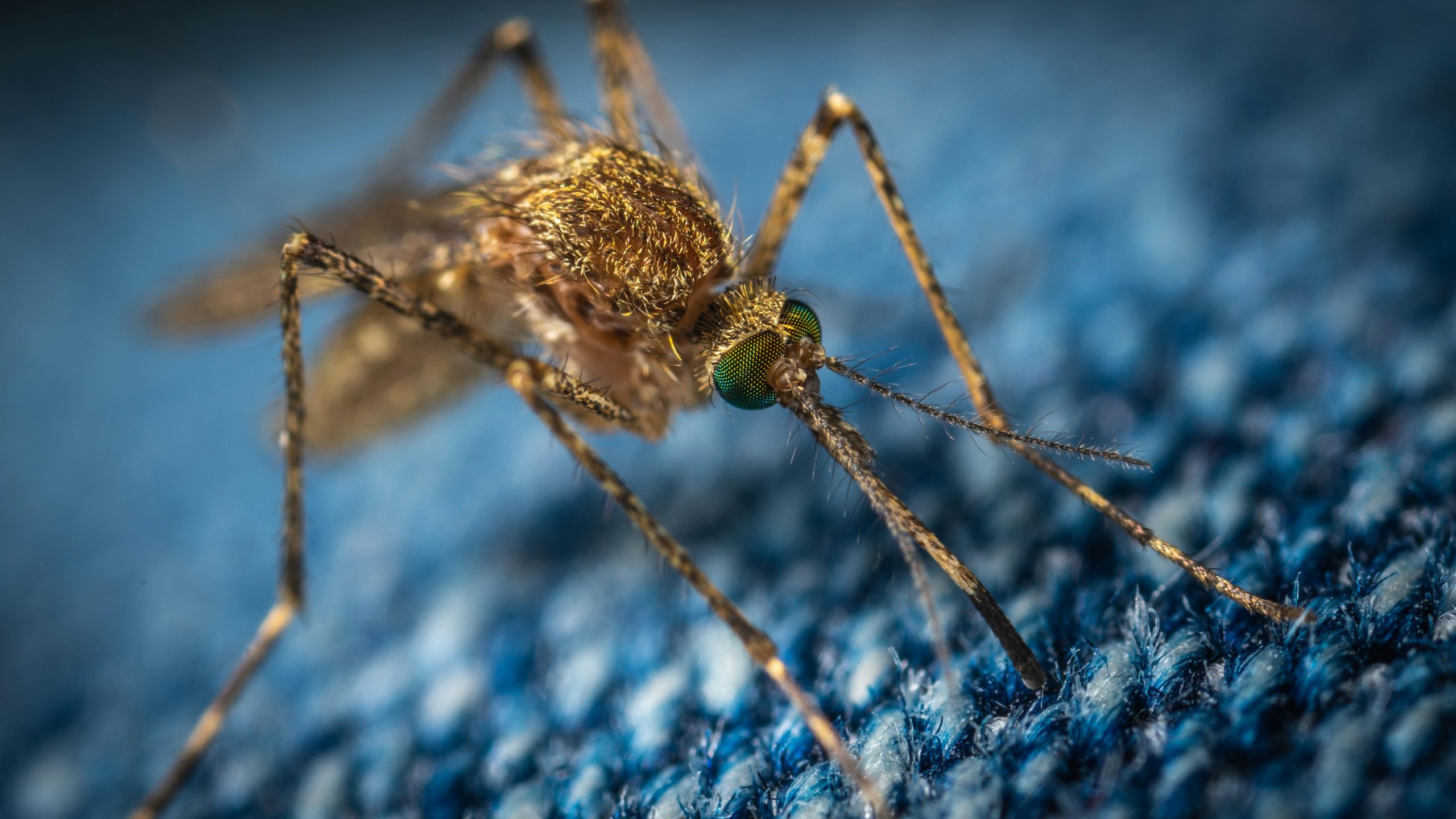Introduction
When thinking of the world’s deadliest animals, one may conjure images of large carnivores with fierce canines—lions, crocodiles, perhaps a venomous snake. But think smaller: The single most deadly organism on earth is none other than the mosquito. The Anopheles Mosquito is the worst of all, harboring the Plasmodium spp. parasites that cause malaria. Over 608,000 people died in 2022 from malaria, with most cases happening in Africa to children under five years old.1 Malaria is a public health concern of utmost importance, and a promising avenue for mitigating the public health threat presented by malaria may be investigating mosquito olfactory or smell.
Malaria is spread by female Anopheles mosquitoes, who need foreign blood for their eggs to develop. This species is a vector, or carrier, of Plasmodium, the parasite that causes malaria in humans. Feeding primarily at night, when an infected female mosquito bites a human, the parasite travels through the bloodstream and enters the human liver, where it incubates for 6-14 days before being released back into the bloodstream. The parasite subsequently infects & destroys red blood cells, which can cause anemia, organ failure, brain damage, and often death. When Anopheles mosquitoes bite an infected human, the mosquito contracts the Plasmodium and inundates their next healthy victim with the parasite.
Mosquitoes’ Olfactory System and Mechanisms of Transmission

To locate humans, mosquitoes have two receptors involved in olfaction: olfactory receptors (OR) and ionotropic receptors (IR), which work together to sense the unique combination of odors mammals emit. Anopheles mosquitoes, in particular, are strongly attracted to humans over other mammals, and odor compounds like lactic acid and carboxylic acid that humans express more strongly than other mammals are likely the culprits.2 Interestingly, Plasmodium can cause humans to express more of these compounds than non-infected humans, making them more attractive to mosquitoes. Over the course of a malaria infection, breath-odor compounds like thioesters (molecules with oxygen and sulfur) become 50 to 100 times stronger.3 Mosquito biting behaviors also become stronger and more frequent when they carry Plasmodium. The changes in humans and mosquitoes caused by Plasmodium make evolutionary sense because, by increasing deadly human-mosquito interactions, the parasite increases its survival chances. Based on this information, we can conclude that mosquito-human interactions drastically increase when either side harbors Plasmodium spp. and that specific odor components are major factors in this interaction increase.
Current Vector Control Methods
There are four main stages of spreading malaria. First, female Anopheles mosquitoes must locate and distinguish a human host infected with Plasmodium. Next, they bite the human and are subsequently infected with the parasite. Then, the mosquito participates in a range of behaviors, such as foraging, mating, and ovipositing (laying eggs). Finally, the mosquito locates a healthy human and bites it, spreading the Plasmodium parasite.
One of the most effective—and realistic—avenues for treating malaria is vector control, or reducing contact with the Anopheles mosquitoes at each of the four stages of malaria spread. The “Push-Pull” strategy uses certain odors to “push” mosquitoes away from humans and other odors to “pull” mosquitoes toward other locations that trap and kill them. Plant-based repellents include lemongrass oil or nepetalactone from catnip extract, while chemical ones include industry standards like DEET, sometimes favored for their longer-lasting effects. However, problems arise with these current substances. DEET, for example, is not widely used in endemic areas due to its unpleasant smell, high cost, and potential adverse health impacts like skin irritation. By better understanding the olfactory mechanisms behind mosquitoes sensing human odors, we can create more attractive and repellent compounds that will help reduce contact with mosquitoes.
New Research on the Olfactory System
Researchers found that Aedes Aegypti mosquitoes (a species that spreads Dengue, Zika virus, Yellow fever, and more) whose ionotropic receptor IR8a was disrupted were not attracted to lactic acid. This is significant given that current research highlights lactic acid as an important odor that helps mosquitoes distinguish humans from other mammals. The IR8a mutants also could not sense other acidic compounds of human odor.2

(First graph): shows the mapping of how the mosquitoes’ cpA neuron reacts to different odorants. The size of the circle shows the intensity of activity evoked by the odorant.
(Second and third graph): shows an analysis of odors in this chemical space, and the third graph has circles with size corresponding to cpA activation.
While IR8a had no effect on carbon dioxide attraction, a separate investigation of the cpA neuron involved in carbon dioxide detection led to the discovery of two promising compounds: ethyl pyruvate, which repelled mosquitoes, and cyclopentanone, which attracted them. Notably, cyclopentanone is the first chemical found with the ability to trap mosquitoes at similar rates to carbon dioxide.4 Carbon dioxide remains an important attractant, with mosquitoes able to sense exhaled carbon dioxide from over 30 feet away.5
Future Directions
Carbon dioxide traps are expensive to produce and, as a result, ineffective control strategies in developing countries where infectious diseases are most prevalent. The potency of cyclopentanone, a pleasant-smelling, affordable, and food-grade safe compound, offers an alternative to other “pull” strategies. In addition, ethyl pyruvate, which is fruity smelling, affordable, and food-grade safe, offers a more viable “push” strategy.
These discoveries suggest the potential for an affordable two-pronged vector control strategy. Knowledge regarding mosquitoes’ behaviors can be applied to limit biting behavior at each stage of their reproduction. For example, to encourage different sites of oviposition, the act of laying eggs can be promoted in areas far away from human dwellings by adding cyclopentanone to those locations. In high-density endemic cities, the chemical can also be used to lure mosquitoes to lay eggs in traps where they cannot proliferate. By attracting male mosquitoes away from human dwellings, where female mosquitoes are more likely to congregate around, we can also attempt to limit mosquito mating so female mosquitoes have no reason to search for blood meals.
A “pull” strategy that is just as attractive as a human host has yet to be found. However, mechanisms like the IR8a pathway’s association with lactic acid attraction and cyclopentane acting as a potent carbon dioxide mimicking compound signal hope that we can create an effective odor repellent.
Challenges
While research is promising, there are a range of issues with exploiting mosquitoes’ olfactory systems. The first is that their olfactory system is extremely robust, with one olfactory neuron triggering many odor receptors. Thus, CRISPR gene editing technology used to “turn off” one or two important neurons or receptors is, unfortunately, not a plausible solution.6 Different species of mosquitoes and different strains of Plasmodium have various effects and odor attractions, so the research on the IR8a pathway may not be relevant to all types of mosquitoes. Additionally, mosquitoes adapt rapidly to control strategies that could decrease the effectiveness of these attractants and repellents. Addressing these complications means it is important to tackle each step of the malaria infection process with additional strategies such as adopting bed nets and routinely removing standing water to limit interactions.
Conclusion
Mosquito control must be non-toxic, affordable, and easy to produce globally for it to be effective. Developments related to the genetics of mosquitoes and compounds for mosquito control have little point unless they can be produced in endemic areas or are easily transportable. Further research into exploiting the IR8a pathway’s connection to lactic acid and testing uses of ethyl pyruvate and cyclopentanone offer new and accessible strategies for mosquito control.
Malaria exacerbates cycles of poverty by creating the constant financial and emotional burden of health crises. In discussions of diseases like malaria, staggering statistics are often offered, but the tragedy seems foreign to the developed world. We must reframe our mindset to understand malaria as part of our world so empathy can better lead the way for solutions. Further investigation into the olfaction of mosquitoes, the driver behind human-mosquito attraction, can help limit the spread of malaria, creating a more equitable world with resilient communities.
Acknowledgements
Thank you to Joshua Raji for peer-reviewing this article.
References
- World Health Organization. (2024). World Malaria Day 2024. https://www.who.int/campaigns/world-malaria-day/2024
- Raji, J. I., Melo, N., Castillo, J. S., Gonzalez, S., Saldana, V., Stensmyr, M. C., & DeGennaro, M. (2019). Aedes aegypti Mosquitoes Detect Acidic Volatiles Found in Human Odor Using the IR8a Pathway. Current Biology, 29(8), 1253-1262.e7. https://doi.org/10.1016/j.cub.2019.02.045
- Konopka, J. K., Task, D., Afify, A., Raji, J., Deibel, K., Maguire, S., Lawrence, R., & Potter, C. J. (2021). Olfaction in Anopheles mosquitoes. Chemical Senses, 46, bjab021. https://doi.org/10.1093/chemse/bjab021
- Tauxe, G. M., MacWilliam, D., Boyle, S. M., Guda, T., & Ray, A. (2013). Targeting a dual detector of skin and CO2 to modify mosquito host seeking. Cell, 155(6), 1365–1379. https://doi.org/10.1016/j.cell.2013.11.013
- Gillies, M. T., & Wilkes, T. J. (1970). The range of attraction of single baits for some West African mosquitoes. Bulletin of Entomological Research, 60(2), 225–235. https://doi.org/10.1017/S000748530004075X
- Herre, M., Goldman, O. V., Lu, T.-C., Caballero-Vidal, G., Qi, Y., Gilbert, Z. N., Gong, Z., Morita, T., Rahiel, S., Ghaninia, M., Ignell, R., Matthews, B. J., Li, H., Vosshall, L. B., & Younger, M. A. (2022). Non-canonical odor coding in the mosquito. Cell, 185(17), 3104-3123.e28. https://doi.org/10.1016/j.cell.2022.07.024
- Zwiebel, L. J., & Takken, W. (2004). Olfactory regulation of mosquito–host interactions. Insect Biochemistry and Molecular Biology, 34(7), 645–652. https://doi.org/10.1016/j.ibmb.2004.03.017
- Dekker, T., Steib, B., Cardé, R. T., & Geier, M. (2002). L‐lactic acid: A human‐signifying host cue for the anthropophilic mosquito Anopheles gambiae. Medical and Veterinary Entomology, 16(1), 91–98. https://doi.org/10.1046/j.0269-283x.2002.00345.x
Image References
- Potter, C. J. (2014). Stop the Biting: Targeting a Mosquito’s Sense of Smell. Cell, 156(5), 878–881. https://doi.org/10.1016/j.cell.2014.02.003
- Tauxe, G. M., MacWilliam, D., Boyle, S. M., Guda, T., & Ray, A. (2013). Targeting a dual detector of skin and CO2 to modify mosquito host seeking. Cell, 155(6), 1365–1379. https://doi.org/10.1016/j.cell.2013.11.013
